人教版(2019)必修 第一册Welcome unit英语句子成分分析课件(70张ppt)
文档属性
| 名称 | 人教版(2019)必修 第一册Welcome unit英语句子成分分析课件(70张ppt) | 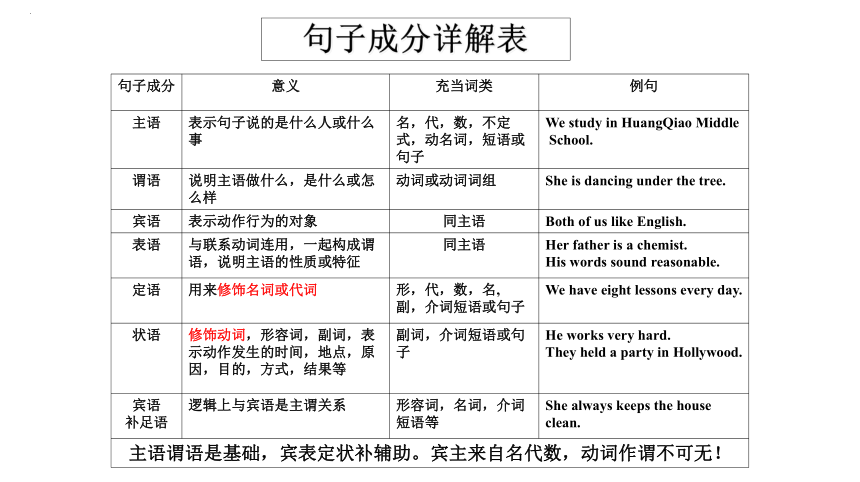 | |
| 格式 | zip | ||
| 文件大小 | 3.1MB | ||
| 资源类型 | 教案 | ||
| 版本资源 | 人教版(2019) | ||
| 科目 | 英语 | ||
| 更新时间 | 2022-06-20 14:29:18 | ||
图片预览

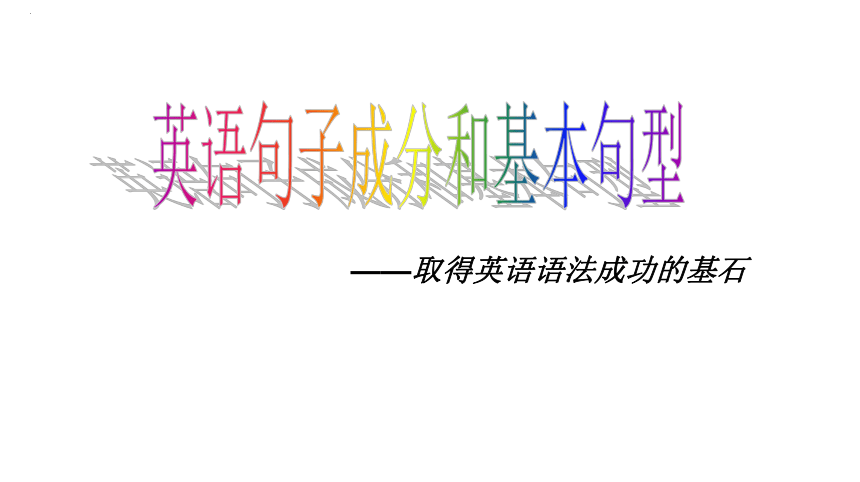
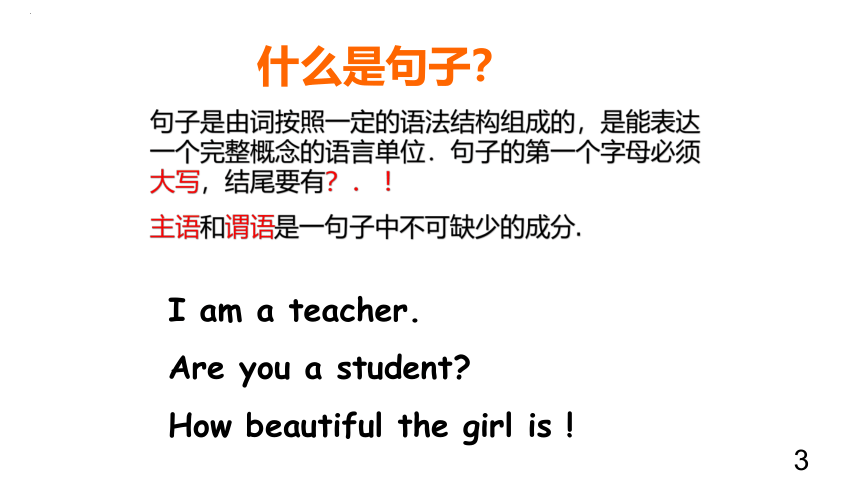
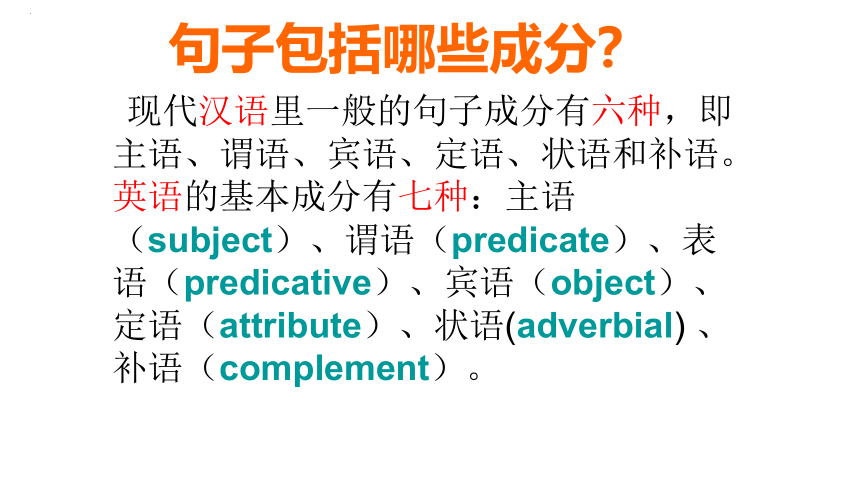
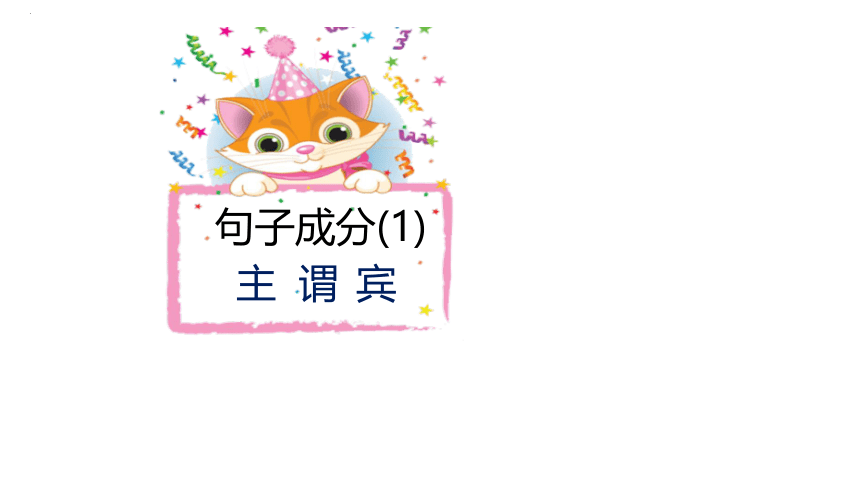
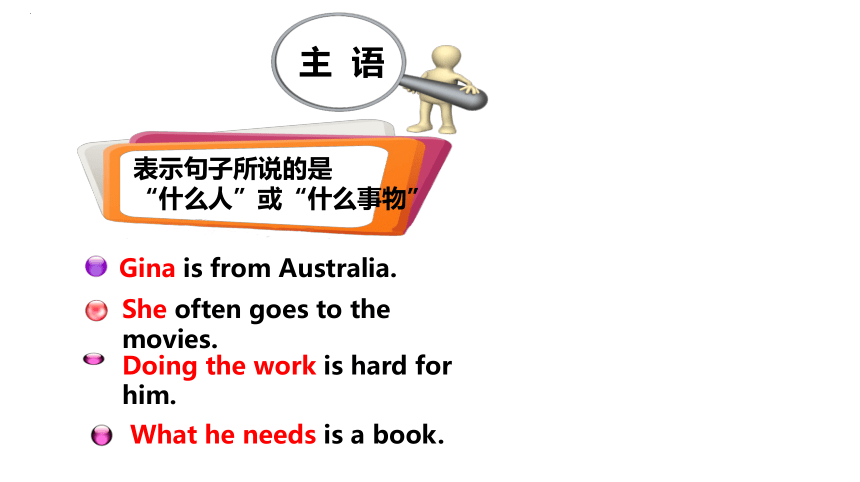
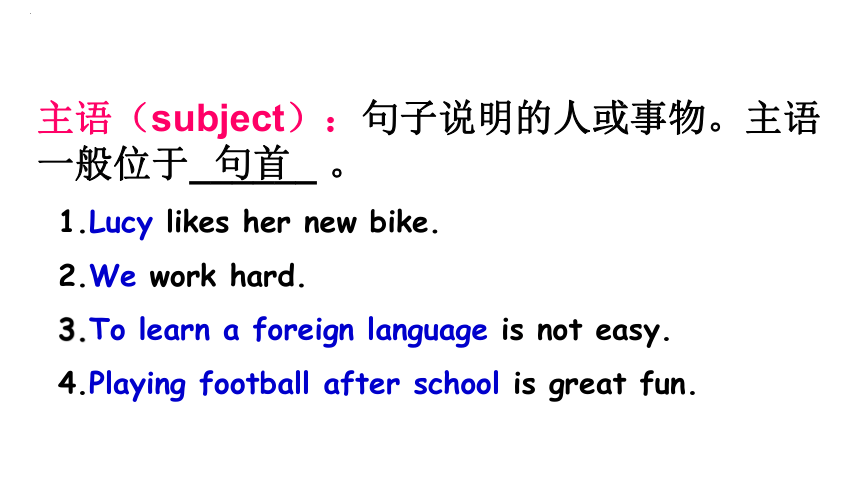
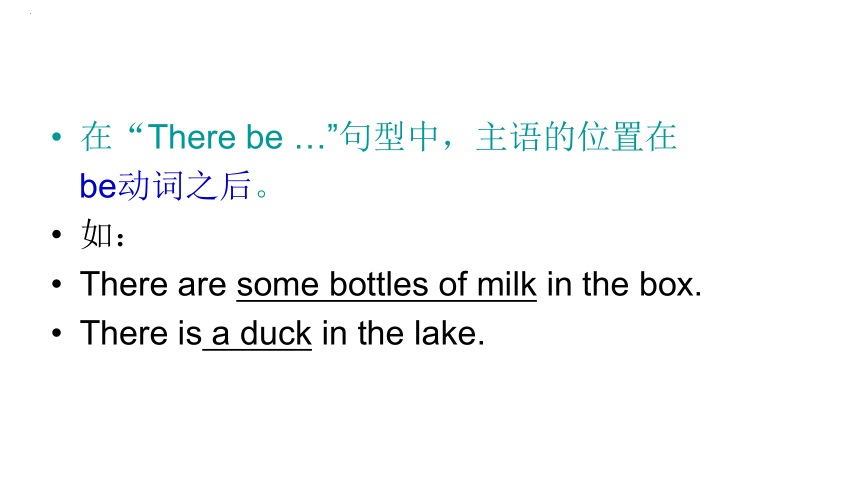
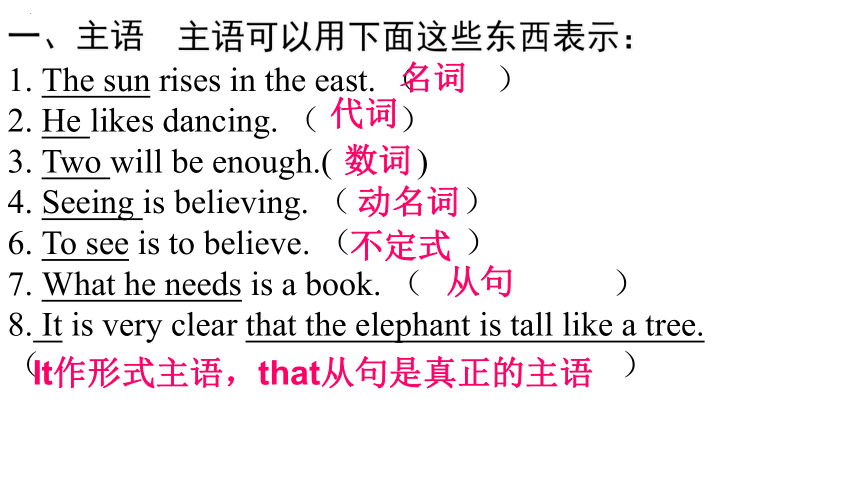
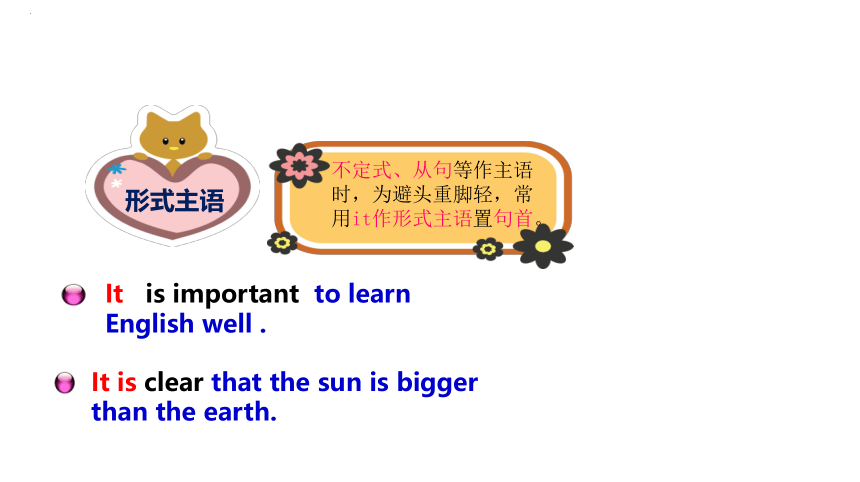
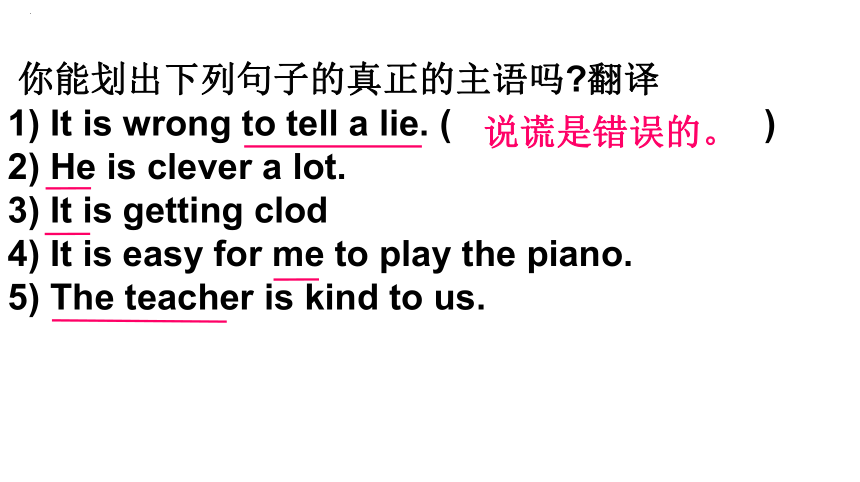
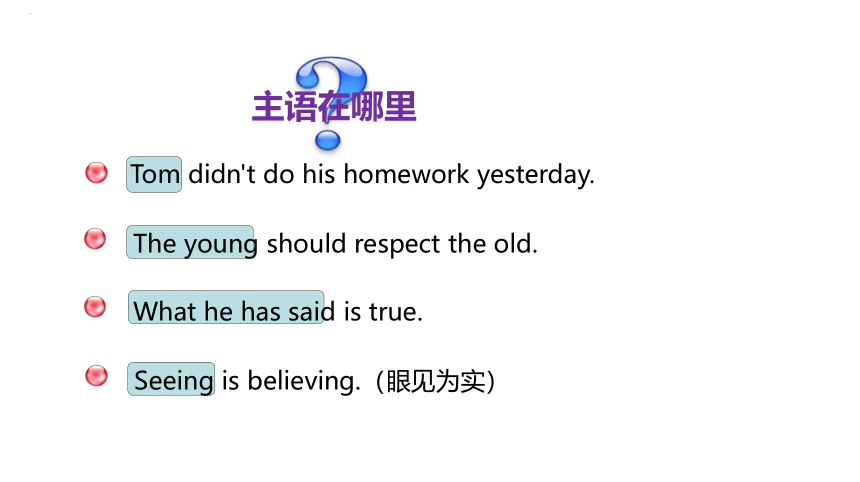
文档简介
(共70张PPT)
句子成分详解表
句子成分 意义 充当词类 例句
主语 表示句子说的是什么人或什么 事 名,代,数,不定 式,动名词,短语或 句子 We study in HuangQiao Middle
School.
谓语 说明主语做什么,是什么或怎 么样 动词或动词词组 She is dancing under the tree.
宾语 表示动作行为的对象 同主语 Both of us like English.
表语 与联系动词连用,一起构成谓 语,说明主语的性质或特征 同主语 Her father is a chemist.
His words sound reasonable.
定语 用来修饰名词或代词 形,代,数,名, 副,介词短语或句子 We have eight lessons every day.
状语 修饰动词,形容词,副词,表 示动作发生的时间,地点,原 因,目的,方式,结果等 副词,介词短语或句 子 He works very hard.
They held a party in Hollywood.
宾语 补足语 逻辑上与宾语是主谓关系 形容词,名词,介词 短语等 She always keeps the house
clean.
主语谓语是基础,宾表定状补辅助。宾主来自名代数,动词作谓不可无!
——取得英语语法成功的基石
英语句子成分和基本句型
什么是句子?
句子是由词按照一定的语法结构组成的,是能表达一个完整概念的语言单位.句子的第一个字母必须大写,结尾要有?. !
主语和谓语是一句子中不可缺少的成分.
I am a teacher.
Are you a student
How beautiful the girl is !
3
现代汉语里一般的句子成分有六种,即主语、谓语、宾语、定语、状语和补语。英语的基本成分有七种:主语(subject)、谓语(predicate)、表语(predicative)、宾语(object)、定语(attribute)、状语(adverbial) 、补语(complement)。
句子包括哪些成分?
句子成分(1)
谓
主
宾
表示句子所说的是
“什么人”或“什么事物”
主 语
What he needs is a book.
Gina is from Australia.
She often goes to the movies.
Doing the work is hard for him.
主语(subject):句子说明的人或事物。主语一般位于______ 。
1.Lucy likes her new bike.
2.We work hard.
3.To learn a foreign language is not easy.
4.Playing football after school is great fun.
句首
在“There be …”句型中,主语的位置在
be动词之后。
如:
There are some bottles of milk in the box.
There is a duck in the lake.
一、主语 主语可以用下面这些东西表示:
1. The sun rises in the east. ( )
2. He likes dancing. ( )
3. Two will be enough.( )
4. Seeing is believing. ( )
6. To see is to believe. ( )
7. What he needs is a book. ( )
8. It is very clear that the elephant is tall like a tree.
( )
名词
代词
数词
动名词
不定式
从句
It作形式主语,that从句是真正的主语
形式主语
It is clear that the sun is bigger than the earth.
It is important to learn English well .
不定式、从句等作主语时,为避头重脚轻,常用it作形式主语置句首。
你能划出下列句子的真正的主语吗 翻译
1) It is wrong to tell a lie. ( )
2) He is clever a lot.
3) It is getting clod
4) It is easy for me to play the piano.
5) The teacher is kind to us.
说谎是错误的。
主语在哪里
The young should respect the old.
Tom didn't do his homework yesterday.
What he has said is true.
Seeing is believing.(眼见为实)
说明主语“做什么” 或“怎么样”, 谓语通常是动词。
主谓要一致
谓 语
We love China.
He has a bad cold.
1. We love China.
2. We have finished reading this book.
3. He can speak English.
4. She seems tired.
谓语:说明主语做什么或怎么样。通常由
______ 充当.
实义动词或系动词
动词常分为实义动词,连系动词,情态动词和助动词.
△情态动词和助动词不能单独充当谓语,必须和实义动词或系动词一起构成谓语.
They can speak English well.
They are playing over there.
动词常分为实义动词,连系动词,情态动词和助动词.
We have finished reading this book.
谓语在哪里
They can speak English well.
助动词和情态动词须和实义动词一起构成谓语
He looked after two boys.
They enjoyed playing computer games.
look after照顾
表示动作, 行为的对象
说明主语“做了什么”
(所做的事)
宾 语
Can I ask some questions
He is looking at the dog.
宾语一般放在及物动词或介词后
宾语是动作,行为的对象,由名词,代词,短语,不定式,动名词,从句充当.它和及物动词一起说明主语做了什么,在谓语、介词之后.
宾语:动作行为的对象,说明主语做什么。一般放在_________或_______后面.
1.We study English.
2.Our teacher said that he would go there.
3.He is looking at the dog.
△双宾语:指人的是间接宾语,指物的是直接宾语。
He gave me two books.
及物动词
介词
间接宾语
直接宾语
He gave me two books.
Tom teaches us English.
双宾语
人是间接宾语物是直接宾语
常跟双宾语的词 give , buy,
teach
二、宾语可以用下面这些东西表示:
1.She lived a happy life.( )
2.I love you.( )
3.We need two.( )
4.Do you mind my opening the door ( )
5.He began to learn English a year ago.( )
6.He did not know what to say.( )
7.Did you write down what she said ( )
8. She felt it her duty to take good care of them.
( )
名词
代词
数词
动名词
不定式
疑问词+不定式
从句
It作形式宾语,不定式是真正的宾语
My brother hasn’t done his homework.
A B C D
You must pay good attention to
A B
your pronunciation.
C D
宾语在哪里
Summary
2
谓语 “做….” 或“怎么样”
3
宾语 动作行为”做”的对象
主语 “什么人”或“什么事”
1
She is a beautiful girl.
句子成分(2)
定状补表
说明主语“是什么”, “怎么样” 位于系动词之后
表 语
Her mother is a bank clerk.
The food tastes delicious.
表语说明主语是什么,或者怎么样,由名词,形容词,
副词,介词短语,不定式,动名词,短语,或者从句充当.表语位于系动词后面.
表语:跟在 后面的词语或从句,用来说明主语的身份,特征,状态.
The trees turn green.
The flower is beautiful .
系动词
He always kept silent at meeting.
系动词
状态系动词 表示主语状态、身份等,主要有be(is am are)
I am hungry.
持续系动词 表示主语继续或保持一种状况或态度,主要有keep, remain, stay等。
He became mad after that.
系动词
感官系动词 主要有feel, smell, sound, taste, look等。
This flower smells very sweet.
变化系动词 表示主语变化,主要有become, grow, turn, fall, get, go, come等。
表语 表语可以用下面这些东西表示:
He is a teacher. ( )
My idea is this.( )
To see is to believe.( )
I feel much better today./I must be off now. ( )
He is out of danger.( )
The news was exciting./They were excited at the news.( )
What surprised me most was that he spoke Chinese so well.( )
名词
代词
不定式
从句
形容词/副词
介词短语
分词
找出表语
Every thing looks nice.
His face turned red.
He is happy.
修饰名词或代词
定 语
She’s a good basketball player.
What’s your name
The girl with long hair is my sister.
定语:用来修饰_____ .
This is a red car.
The building is their teaching building.
The woman doctor is my wife.
I have something to tell you.
The man in front of the door is Mr. Li.
Every student has an English book.
五、定语
名词和代词
三、定语 定语可以用下面这些东西表示:
It’s a red car.( )
They live in the room above.( )
My brother is a teacher.( )
We belong to the third world.( )
Lucy’s father is a poor worker.( )
Mother made a birthday cake for me.( )
The man under the tree is my teacher.( )
The swimming boy is my brother./The boy swimming in the river is my brother. ( )
形容词
副词
代词
数词
名词所有格
名词
介词短语
现在分词
找出定语
Some people forgot to sweep the floor.
A B C D
The man downstairs was trying to sleep.
A B C D
修饰动词、形容词、副词或全句, 说明时间、地点、方式、因果、条件、让步、方向、程度、目的等。
状 语
The students followed Uncle Wang
to see the other machines.
He sat there quietly.
四、状语 状语可以用下面这些东西表示:
He is often late for class.( )
We saw that picture at the cinema.( )
He sat there smoking.( )
They returned tired and hungry. ( )
They did everything they could to save the boy’s life. ( )
Although he is young, he knows a lot. ( )
The box is so heavy that I can’t lift it. ( )
副词,程度
介词短语,地点
分词,伴随
不定式,目的
形容词,状态
让步状语从句
结果状语从句
四、状语可以用下面这些东西表示:
While my wife was reading the newspaper, I was watching TV. ( )
He was angry because we were late.( )
If it rains tomorrow, we won’t go out.( )
时间状语从句
原因状语从句
条件状语从句
找出状语
He began writing when he was eleven. A B C D
There was a big smile on her face.
A B C D
用来补充说明宾语的情况
宾语
补足语
We elected him our monitor.
He asked her to take the boy out of school.
注意点
某些及物动词的宾语后面还需要有一个补足语,意思才完整,宾语和它的补足语构成复合宾语。比如说:
I like to keep everything tidy.
I'm going to paint it pink.
感官动词和使役动词加宾补,如:See,hear, notice, watch, hear,feel , observe(感官动词), Make,have, let(使役动词),接宾补时,不定式的符号to必须省略。在help后,不定式可以带to,也可不带。
1. I hear him sing .
2. Let him help you.
五、宾语补足语:
I consider Jim a good friend.( )
I always find her happy.( )
People praised him as a hero.( )
I had the TV fixed.( )
I saw him entering the building.( )
What made you think so ( )
Do you want me to go ( )
形容词
名词
介词短语
过去分词
现在分词
省略掉to的不定式
不定式
I saw Mr. Wang get on the bus. A B C D
They call me Lily sometimes.
A B C D
找出宾补
Summary
2
定语用来修饰名词或代词
3
状语修饰动词,形容词或副词
4
宾补用来补充说明宾语的情况
表语“是什么”,”怎么样”
1
句子成份练习
1、You should study hard.
2、The teacher got very angry.
3、The boy told me his story.
4、We elected him our monitor.
5、The sun keeps us warm.
6、I told him to open the window.
7、We watched the train leaving the station.
状语
表语
间语+直宾
宾语+宾补
宾语+宾补
宾语+宾补
宾语+宾补
8. I think it difficult to finish the work this morning.
9. There seems little hopes of success.
10、To our joy, they arrived safe.
11、The fact is very clear that our team will win the game.
12. After graduation he will work where he came from.
宾语+宾补
主语
状语
同位语
状语
有哪几种常见的句型结构?
按句子的结构可分三种:简单句、并列句和复合句。
简单句:只有一个主语(或并列主语)和一个谓语(或并列谓语)。
e.g. He often reads English in the morning.
Tom and Mike are American boys.
They walked, talked and laughed.
英语句子的基本结构可以归纳成五种基本句型
掌握这五种基本句型,是掌握各种英语句子结构的基础。
一: S V (主+谓)
二: S V P (主+系+表)
三: S V O (主+谓+宾)
四: S V o O (主+谓+间宾+直宾)
五: S V O C (主+谓+宾+宾补)
基本句型 二
S +V +P(主+系+表)
此句型的句子有一个共同的特点:句子谓语动词都不能表达一个完整的意思,必须加上一个表明主语身份或状态的表语构成复合谓语,才能表达完整的意思。这类动词叫做连系动词。系动词分两类:be, look, feel,smell,taste,sound等属一类,表示情况;get, grow, become, turn,go等属另一类,表示变化。be 本身没有什么意义,只起连系主语和表语的作用。
S V(是系动词) P(表语)
1. This 2. The dinner 3. He 4. Everything 5. He 6. The book 7. The weather 8. His face is smells(闻) fell looks is is became turned an English dictionary.
good.
happy.
different.
tall and strong.
interesting.
warmer.
red.
系动词词义不完整,在句中不能单独使用(除省略句外),后面必须接有表语,系动词和表语一起构成合成谓语。
一、系动词的分类:
常见的系动词大致可分为三类。
第一类:表示特征或状态的,有be, look, feel, seem, appear, smell, taste, sound, turn out(结果是、证明是)等。
You don’t look very well.
I feel rather cold.
第二类:表示从一种状态到另一种状态的变化,有become, get, grow, turn, fall, go, come, run等。
He became a world-famous scientist.
It is getting warmer and warmer.
It grew dark.
The food has turned bad.
第三类:表示保持状态的,有keep, remain, continue,stay等。
Keep quiet, children!
It remains to be proved.
基本句型 三
S +Vt +O(主+谓+宾)
此句型句子的共同特点是:谓语动词都具有实义,都是主语产生的动作,但不能表达完整的意思,必须跟有一个宾语,即动作的承受者,才能使意思完整。这类动词叫做及物动词。
S V(实义动词) O(宾语)
1. Who 2. She 3. He 8. He 5. They 6. Danny 7. I 4. He knows laugh at understands made ate likes want said the answer
her.
English.
cakes.
some apples.
donuts.
to have a cup of tea.
"Good morning."
基本句型 四
S +Vt +IO +O(主+谓+间宾+直宾)
此句型的句子有一个共同特点:谓语动词必须跟有两个宾语才能表达完整的意思。这两个宾语一个是动作的直接承受者,另一个是动作的间接承受者。
通常这一间接承受者用一个介词来连接,当动作的间接承受者在动作的直接承受者之前时,这一介词往往被省略。
S V(及物) o(多指人) O(多指物)
1. She 2. She 3. He 8. He 5. I 6. I 7. I 4. He passed cooked brought bought showed gave told showed him her husband you her him him me a new dress.
a delicious meal.
a dictionary.
nothing.
my pictures.
a hand.
how to run the machine.
that the bus was late.
基本句型 五
S +Vt +O +C(主+谓+宾+宾补)
此句型的句子的共同特点是:动词虽然是及物动词,但是只跟一个宾语还不能表达完整的意思,必须加上一个补充成分来补足宾语,才能使意思完整。
S V(及物) O(宾语) C(宾补)
1. We 2. They 3. They 4. They 5. What 6. We 7. He 8. I keep painted call found makes saw asked saw the table the door supper the house him him me them clean.
green.
dinner.
dirty.
sad
out.
to come back soon.
getting on the bus.
用 it 做形式宾语,而将真正的宾语放到宾语补足语的后面,以使句子结构平衡,是英语常用的句型结构方式。即:主语+谓语+it+宾补+真正宾语。如:
I found it very pleasant to be with your family.
并列句
定 义
用 法
并列句是由and, but, or, for等并列连词把两个或两个以上意义有关的简单句连在一起而构成的句子。其结构为:简单句+并列连词+简单句。并列句是初中英语语法的重点和难点,也是中考的常考知识点之一。要想真正、全面掌握并列句,就让我们一起聆听它的“四重奏”吧!
定义
并列句是由and, but, or, for等并列连词把两个或两个以上意义有关的简单句连在一起而构成的句子。其结构为:简单句+并列连词+简单句。并列句是初中英语语法的重点和难点,也是中考的常考知识点之一。要想真正、全面掌握并列句,就让我们一起聆听它的“四重奏”吧!
定义
联合并列句
并列连词:and(和、并且), 其中and意为“和、又、而”, 表示动作先后等,not only...but also...(不但……而且……)等。
Jim finished his homework and he went to bed.
吉姆写完作业,就上床睡觉了。
Not only I come to school early, but also my teacher does. 不但我到校早,而且我的老师也是如此。
and在表示条件时,可与if引导的肯定条件句转换
keep passing the ball to each other, and you”ll be Ok!
If you keep passing the ball each other, you”ll be Ok!
转折并列句
并列连词:but(但是),however(然而),yet(但是),while(而,然而)等。其中but意为“但是、可是、然而、不过”,表意思转折 。
She’s good at English, but her Chinese isn’t good.
她擅长英语,但语文不好。
He worked hard, yet he failed. 他努力地干,然而失败了。
Tom is tall while his brother is short.
汤姆个儿很高,而他的兄弟却很矮。
I’d like to go with you, however my hands are full.
我想和你一块儿去,可是我忙不过来。
特别提醒: though, although(虽然,尽管)不能
与 but(但是)连用。
虽然他很累,但是他没有停止工作。
误:Although he is very tired, but he doesn’t stop working.
正:Although he is very tired, he doesn’t stop working.
正:He is very tired, but he doesn’t stop working.
选择并列句
并列连词:or(或者;否则,要不然),either...or...(或者……或者……),neither... nor...(既不……又不……)等。
You must tell the truth, or you will be punished.
你必须说真话,否则你将会受到惩罚。
Either you can do it by yourself, or you can ask
someone else to do it. 你或者自己做,或者让别人去做。
提醒:“祈使句+or/and+简单句”也是一个固定句型,此句型中的祈使句在意义上相当于一个if引导的条件状语从句 。
Work hard, and you’ll pass the exam.
(=If you work hard, you’ll pass the exam.)
努力学习,你就会通过考试。
因果并列句
并列连词:for(因为),表示因果关系,起解释说明的作用。
so(所以)等。其中so为“所以、结果”,表因果关系。
That was our first lesson, so she didn’t know all our names.
那是我们第一堂课,因此她并不知道我们所有人的名字。
She didn’t come to school today, for she was ill.
今天她没来上学,因为她生病了。
提醒: so与because不能连用。
因为我有钱,所以我能给自己买很多东西。
误:Because I’m rich, so I can buy myself lots of things.
正:Because I’m rich, I can buy myself lots of things.
正:I’m rich, so I can buy myself lots of things.
3)复合句:含有一个或一个以上从句的句子。复合句包含:名词性从句(主语从句、宾语从句、表语从句和同位语从句)、定语从句和状语从句等。
e.g. The foreign visitors took a lot of pictures when they were at the Great Wall.
70
句子成分详解表
句子成分 意义 充当词类 例句
主语 表示句子说的是什么人或什么 事 名,代,数,不定 式,动名词,短语或 句子 We study in HuangQiao Middle
School.
谓语 说明主语做什么,是什么或怎 么样 动词或动词词组 She is dancing under the tree.
宾语 表示动作行为的对象 同主语 Both of us like English.
表语 与联系动词连用,一起构成谓 语,说明主语的性质或特征 同主语 Her father is a chemist.
His words sound reasonable.
定语 用来修饰名词或代词 形,代,数,名, 副,介词短语或句子 We have eight lessons every day.
状语 修饰动词,形容词,副词,表 示动作发生的时间,地点,原 因,目的,方式,结果等 副词,介词短语或句 子 He works very hard.
They held a party in Hollywood.
宾语 补足语 逻辑上与宾语是主谓关系 形容词,名词,介词 短语等 She always keeps the house
clean.
主语谓语是基础,宾表定状补辅助。宾主来自名代数,动词作谓不可无!
——取得英语语法成功的基石
英语句子成分和基本句型
什么是句子?
句子是由词按照一定的语法结构组成的,是能表达一个完整概念的语言单位.句子的第一个字母必须大写,结尾要有?. !
主语和谓语是一句子中不可缺少的成分.
I am a teacher.
Are you a student
How beautiful the girl is !
3
现代汉语里一般的句子成分有六种,即主语、谓语、宾语、定语、状语和补语。英语的基本成分有七种:主语(subject)、谓语(predicate)、表语(predicative)、宾语(object)、定语(attribute)、状语(adverbial) 、补语(complement)。
句子包括哪些成分?
句子成分(1)
谓
主
宾
表示句子所说的是
“什么人”或“什么事物”
主 语
What he needs is a book.
Gina is from Australia.
She often goes to the movies.
Doing the work is hard for him.
主语(subject):句子说明的人或事物。主语一般位于______ 。
1.Lucy likes her new bike.
2.We work hard.
3.To learn a foreign language is not easy.
4.Playing football after school is great fun.
句首
在“There be …”句型中,主语的位置在
be动词之后。
如:
There are some bottles of milk in the box.
There is a duck in the lake.
一、主语 主语可以用下面这些东西表示:
1. The sun rises in the east. ( )
2. He likes dancing. ( )
3. Two will be enough.( )
4. Seeing is believing. ( )
6. To see is to believe. ( )
7. What he needs is a book. ( )
8. It is very clear that the elephant is tall like a tree.
( )
名词
代词
数词
动名词
不定式
从句
It作形式主语,that从句是真正的主语
形式主语
It is clear that the sun is bigger than the earth.
It is important to learn English well .
不定式、从句等作主语时,为避头重脚轻,常用it作形式主语置句首。
你能划出下列句子的真正的主语吗 翻译
1) It is wrong to tell a lie. ( )
2) He is clever a lot.
3) It is getting clod
4) It is easy for me to play the piano.
5) The teacher is kind to us.
说谎是错误的。
主语在哪里
The young should respect the old.
Tom didn't do his homework yesterday.
What he has said is true.
Seeing is believing.(眼见为实)
说明主语“做什么” 或“怎么样”, 谓语通常是动词。
主谓要一致
谓 语
We love China.
He has a bad cold.
1. We love China.
2. We have finished reading this book.
3. He can speak English.
4. She seems tired.
谓语:说明主语做什么或怎么样。通常由
______ 充当.
实义动词或系动词
动词常分为实义动词,连系动词,情态动词和助动词.
△情态动词和助动词不能单独充当谓语,必须和实义动词或系动词一起构成谓语.
They can speak English well.
They are playing over there.
动词常分为实义动词,连系动词,情态动词和助动词.
We have finished reading this book.
谓语在哪里
They can speak English well.
助动词和情态动词须和实义动词一起构成谓语
He looked after two boys.
They enjoyed playing computer games.
look after照顾
表示动作, 行为的对象
说明主语“做了什么”
(所做的事)
宾 语
Can I ask some questions
He is looking at the dog.
宾语一般放在及物动词或介词后
宾语是动作,行为的对象,由名词,代词,短语,不定式,动名词,从句充当.它和及物动词一起说明主语做了什么,在谓语、介词之后.
宾语:动作行为的对象,说明主语做什么。一般放在_________或_______后面.
1.We study English.
2.Our teacher said that he would go there.
3.He is looking at the dog.
△双宾语:指人的是间接宾语,指物的是直接宾语。
He gave me two books.
及物动词
介词
间接宾语
直接宾语
He gave me two books.
Tom teaches us English.
双宾语
人是间接宾语物是直接宾语
常跟双宾语的词 give , buy,
teach
二、宾语可以用下面这些东西表示:
1.She lived a happy life.( )
2.I love you.( )
3.We need two.( )
4.Do you mind my opening the door ( )
5.He began to learn English a year ago.( )
6.He did not know what to say.( )
7.Did you write down what she said ( )
8. She felt it her duty to take good care of them.
( )
名词
代词
数词
动名词
不定式
疑问词+不定式
从句
It作形式宾语,不定式是真正的宾语
My brother hasn’t done his homework.
A B C D
You must pay good attention to
A B
your pronunciation.
C D
宾语在哪里
Summary
2
谓语 “做….” 或“怎么样”
3
宾语 动作行为”做”的对象
主语 “什么人”或“什么事”
1
She is a beautiful girl.
句子成分(2)
定状补表
说明主语“是什么”, “怎么样” 位于系动词之后
表 语
Her mother is a bank clerk.
The food tastes delicious.
表语说明主语是什么,或者怎么样,由名词,形容词,
副词,介词短语,不定式,动名词,短语,或者从句充当.表语位于系动词后面.
表语:跟在 后面的词语或从句,用来说明主语的身份,特征,状态.
The trees turn green.
The flower is beautiful .
系动词
He always kept silent at meeting.
系动词
状态系动词 表示主语状态、身份等,主要有be(is am are)
I am hungry.
持续系动词 表示主语继续或保持一种状况或态度,主要有keep, remain, stay等。
He became mad after that.
系动词
感官系动词 主要有feel, smell, sound, taste, look等。
This flower smells very sweet.
变化系动词 表示主语变化,主要有become, grow, turn, fall, get, go, come等。
表语 表语可以用下面这些东西表示:
He is a teacher. ( )
My idea is this.( )
To see is to believe.( )
I feel much better today./I must be off now. ( )
He is out of danger.( )
The news was exciting./They were excited at the news.( )
What surprised me most was that he spoke Chinese so well.( )
名词
代词
不定式
从句
形容词/副词
介词短语
分词
找出表语
Every thing looks nice.
His face turned red.
He is happy.
修饰名词或代词
定 语
She’s a good basketball player.
What’s your name
The girl with long hair is my sister.
定语:用来修饰_____ .
This is a red car.
The building is their teaching building.
The woman doctor is my wife.
I have something to tell you.
The man in front of the door is Mr. Li.
Every student has an English book.
五、定语
名词和代词
三、定语 定语可以用下面这些东西表示:
It’s a red car.( )
They live in the room above.( )
My brother is a teacher.( )
We belong to the third world.( )
Lucy’s father is a poor worker.( )
Mother made a birthday cake for me.( )
The man under the tree is my teacher.( )
The swimming boy is my brother./The boy swimming in the river is my brother. ( )
形容词
副词
代词
数词
名词所有格
名词
介词短语
现在分词
找出定语
Some people forgot to sweep the floor.
A B C D
The man downstairs was trying to sleep.
A B C D
修饰动词、形容词、副词或全句, 说明时间、地点、方式、因果、条件、让步、方向、程度、目的等。
状 语
The students followed Uncle Wang
to see the other machines.
He sat there quietly.
四、状语 状语可以用下面这些东西表示:
He is often late for class.( )
We saw that picture at the cinema.( )
He sat there smoking.( )
They returned tired and hungry. ( )
They did everything they could to save the boy’s life. ( )
Although he is young, he knows a lot. ( )
The box is so heavy that I can’t lift it. ( )
副词,程度
介词短语,地点
分词,伴随
不定式,目的
形容词,状态
让步状语从句
结果状语从句
四、状语可以用下面这些东西表示:
While my wife was reading the newspaper, I was watching TV. ( )
He was angry because we were late.( )
If it rains tomorrow, we won’t go out.( )
时间状语从句
原因状语从句
条件状语从句
找出状语
He began writing when he was eleven. A B C D
There was a big smile on her face.
A B C D
用来补充说明宾语的情况
宾语
补足语
We elected him our monitor.
He asked her to take the boy out of school.
注意点
某些及物动词的宾语后面还需要有一个补足语,意思才完整,宾语和它的补足语构成复合宾语。比如说:
I like to keep everything tidy.
I'm going to paint it pink.
感官动词和使役动词加宾补,如:See,hear, notice, watch, hear,feel , observe(感官动词), Make,have, let(使役动词),接宾补时,不定式的符号to必须省略。在help后,不定式可以带to,也可不带。
1. I hear him sing .
2. Let him help you.
五、宾语补足语:
I consider Jim a good friend.( )
I always find her happy.( )
People praised him as a hero.( )
I had the TV fixed.( )
I saw him entering the building.( )
What made you think so ( )
Do you want me to go ( )
形容词
名词
介词短语
过去分词
现在分词
省略掉to的不定式
不定式
I saw Mr. Wang get on the bus. A B C D
They call me Lily sometimes.
A B C D
找出宾补
Summary
2
定语用来修饰名词或代词
3
状语修饰动词,形容词或副词
4
宾补用来补充说明宾语的情况
表语“是什么”,”怎么样”
1
句子成份练习
1、You should study hard.
2、The teacher got very angry.
3、The boy told me his story.
4、We elected him our monitor.
5、The sun keeps us warm.
6、I told him to open the window.
7、We watched the train leaving the station.
状语
表语
间语+直宾
宾语+宾补
宾语+宾补
宾语+宾补
宾语+宾补
8. I think it difficult to finish the work this morning.
9. There seems little hopes of success.
10、To our joy, they arrived safe.
11、The fact is very clear that our team will win the game.
12. After graduation he will work where he came from.
宾语+宾补
主语
状语
同位语
状语
有哪几种常见的句型结构?
按句子的结构可分三种:简单句、并列句和复合句。
简单句:只有一个主语(或并列主语)和一个谓语(或并列谓语)。
e.g. He often reads English in the morning.
Tom and Mike are American boys.
They walked, talked and laughed.
英语句子的基本结构可以归纳成五种基本句型
掌握这五种基本句型,是掌握各种英语句子结构的基础。
一: S V (主+谓)
二: S V P (主+系+表)
三: S V O (主+谓+宾)
四: S V o O (主+谓+间宾+直宾)
五: S V O C (主+谓+宾+宾补)
基本句型 二
S +V +P(主+系+表)
此句型的句子有一个共同的特点:句子谓语动词都不能表达一个完整的意思,必须加上一个表明主语身份或状态的表语构成复合谓语,才能表达完整的意思。这类动词叫做连系动词。系动词分两类:be, look, feel,smell,taste,sound等属一类,表示情况;get, grow, become, turn,go等属另一类,表示变化。be 本身没有什么意义,只起连系主语和表语的作用。
S V(是系动词) P(表语)
1. This 2. The dinner 3. He 4. Everything 5. He 6. The book 7. The weather 8. His face is smells(闻) fell looks is is became turned an English dictionary.
good.
happy.
different.
tall and strong.
interesting.
warmer.
red.
系动词词义不完整,在句中不能单独使用(除省略句外),后面必须接有表语,系动词和表语一起构成合成谓语。
一、系动词的分类:
常见的系动词大致可分为三类。
第一类:表示特征或状态的,有be, look, feel, seem, appear, smell, taste, sound, turn out(结果是、证明是)等。
You don’t look very well.
I feel rather cold.
第二类:表示从一种状态到另一种状态的变化,有become, get, grow, turn, fall, go, come, run等。
He became a world-famous scientist.
It is getting warmer and warmer.
It grew dark.
The food has turned bad.
第三类:表示保持状态的,有keep, remain, continue,stay等。
Keep quiet, children!
It remains to be proved.
基本句型 三
S +Vt +O(主+谓+宾)
此句型句子的共同特点是:谓语动词都具有实义,都是主语产生的动作,但不能表达完整的意思,必须跟有一个宾语,即动作的承受者,才能使意思完整。这类动词叫做及物动词。
S V(实义动词) O(宾语)
1. Who 2. She 3. He 8. He 5. They 6. Danny 7. I 4. He knows laugh at understands made ate likes want said the answer
her.
English.
cakes.
some apples.
donuts.
to have a cup of tea.
"Good morning."
基本句型 四
S +Vt +IO +O(主+谓+间宾+直宾)
此句型的句子有一个共同特点:谓语动词必须跟有两个宾语才能表达完整的意思。这两个宾语一个是动作的直接承受者,另一个是动作的间接承受者。
通常这一间接承受者用一个介词来连接,当动作的间接承受者在动作的直接承受者之前时,这一介词往往被省略。
S V(及物) o(多指人) O(多指物)
1. She 2. She 3. He 8. He 5. I 6. I 7. I 4. He passed cooked brought bought showed gave told showed him her husband you her him him me a new dress.
a delicious meal.
a dictionary.
nothing.
my pictures.
a hand.
how to run the machine.
that the bus was late.
基本句型 五
S +Vt +O +C(主+谓+宾+宾补)
此句型的句子的共同特点是:动词虽然是及物动词,但是只跟一个宾语还不能表达完整的意思,必须加上一个补充成分来补足宾语,才能使意思完整。
S V(及物) O(宾语) C(宾补)
1. We 2. They 3. They 4. They 5. What 6. We 7. He 8. I keep painted call found makes saw asked saw the table the door supper the house him him me them clean.
green.
dinner.
dirty.
sad
out.
to come back soon.
getting on the bus.
用 it 做形式宾语,而将真正的宾语放到宾语补足语的后面,以使句子结构平衡,是英语常用的句型结构方式。即:主语+谓语+it+宾补+真正宾语。如:
I found it very pleasant to be with your family.
并列句
定 义
用 法
并列句是由and, but, or, for等并列连词把两个或两个以上意义有关的简单句连在一起而构成的句子。其结构为:简单句+并列连词+简单句。并列句是初中英语语法的重点和难点,也是中考的常考知识点之一。要想真正、全面掌握并列句,就让我们一起聆听它的“四重奏”吧!
定义
并列句是由and, but, or, for等并列连词把两个或两个以上意义有关的简单句连在一起而构成的句子。其结构为:简单句+并列连词+简单句。并列句是初中英语语法的重点和难点,也是中考的常考知识点之一。要想真正、全面掌握并列句,就让我们一起聆听它的“四重奏”吧!
定义
联合并列句
并列连词:and(和、并且), 其中and意为“和、又、而”, 表示动作先后等,not only...but also...(不但……而且……)等。
Jim finished his homework and he went to bed.
吉姆写完作业,就上床睡觉了。
Not only I come to school early, but also my teacher does. 不但我到校早,而且我的老师也是如此。
and在表示条件时,可与if引导的肯定条件句转换
keep passing the ball to each other, and you”ll be Ok!
If you keep passing the ball each other, you”ll be Ok!
转折并列句
并列连词:but(但是),however(然而),yet(但是),while(而,然而)等。其中but意为“但是、可是、然而、不过”,表意思转折 。
She’s good at English, but her Chinese isn’t good.
她擅长英语,但语文不好。
He worked hard, yet he failed. 他努力地干,然而失败了。
Tom is tall while his brother is short.
汤姆个儿很高,而他的兄弟却很矮。
I’d like to go with you, however my hands are full.
我想和你一块儿去,可是我忙不过来。
特别提醒: though, although(虽然,尽管)不能
与 but(但是)连用。
虽然他很累,但是他没有停止工作。
误:Although he is very tired, but he doesn’t stop working.
正:Although he is very tired, he doesn’t stop working.
正:He is very tired, but he doesn’t stop working.
选择并列句
并列连词:or(或者;否则,要不然),either...or...(或者……或者……),neither... nor...(既不……又不……)等。
You must tell the truth, or you will be punished.
你必须说真话,否则你将会受到惩罚。
Either you can do it by yourself, or you can ask
someone else to do it. 你或者自己做,或者让别人去做。
提醒:“祈使句+or/and+简单句”也是一个固定句型,此句型中的祈使句在意义上相当于一个if引导的条件状语从句 。
Work hard, and you’ll pass the exam.
(=If you work hard, you’ll pass the exam.)
努力学习,你就会通过考试。
因果并列句
并列连词:for(因为),表示因果关系,起解释说明的作用。
so(所以)等。其中so为“所以、结果”,表因果关系。
That was our first lesson, so she didn’t know all our names.
那是我们第一堂课,因此她并不知道我们所有人的名字。
She didn’t come to school today, for she was ill.
今天她没来上学,因为她生病了。
提醒: so与because不能连用。
因为我有钱,所以我能给自己买很多东西。
误:Because I’m rich, so I can buy myself lots of things.
正:Because I’m rich, I can buy myself lots of things.
正:I’m rich, so I can buy myself lots of things.
3)复合句:含有一个或一个以上从句的句子。复合句包含:名词性从句(主语从句、宾语从句、表语从句和同位语从句)、定语从句和状语从句等。
e.g. The foreign visitors took a lot of pictures when they were at the Great Wall.
70
